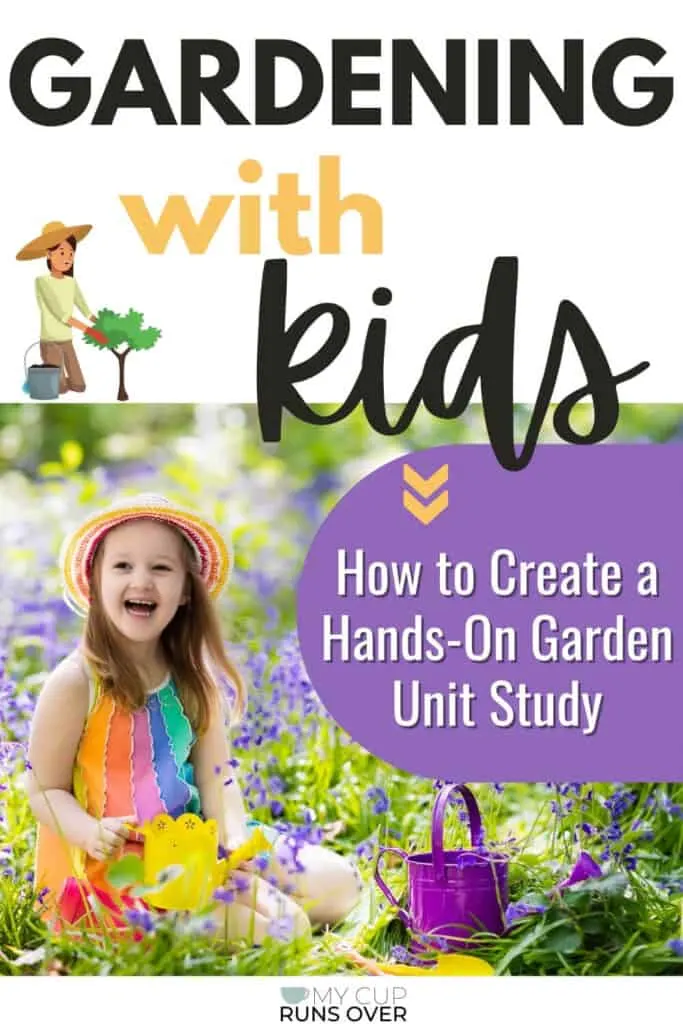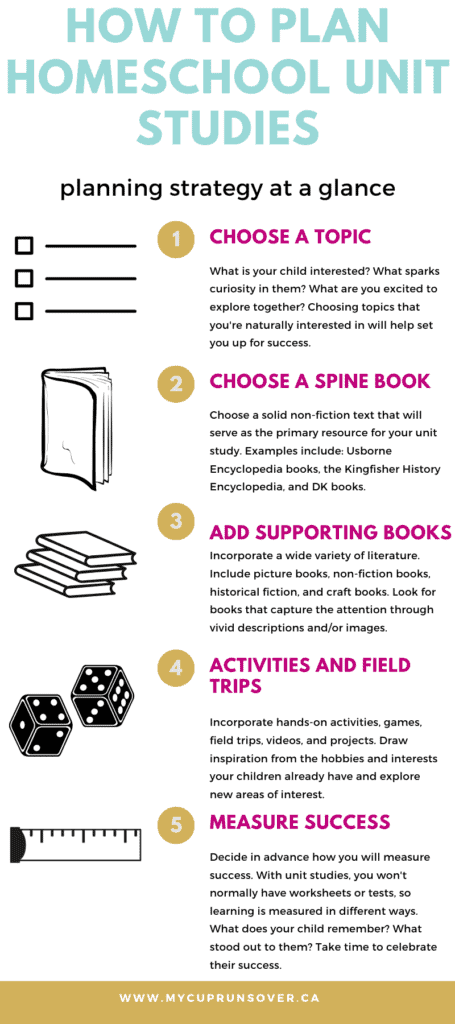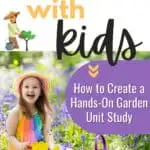Gardening with kids is both enjoyable and educational. If you’re looking to get your hands dirty working in the garden together, but also use the opportunity to introduce topics like botany, ecosystems, and plant science, the resources in this post are exactly what you need. Use them to create the perfect gardening unit study for your kids.

Unit studies are a great way to explore a topic of interest with your children, incorporating deeper learning opportunities into hands-on activities.
While there are tons of free and affordable unit study packages available on the Internet, it can also be fun to create your own unit study so you can truly customize it to your family’s needs and interests.
The image below highlights the steps we recommend when creating your own unit study.

Creating a Unit Study on Gardening with Kids: An Overview
We’ll go into each of the steps in more detail below, but here is a quick overview so you know where we’re headed.
First, you’ll choose one or more spine books to act as your primary resource for the unit study. The book you choose will depend on the scope you want to cover. Do you want to give preschoolers a gentle introduction to the intricacies of garden life? Do you have older kids who are eager to grow their own food? Do you have teens who need to earn biology credits?
You can accomplish any of these goals with a gardening unit study–you’ll just need to choose the appropriate books.
After you have your spine book(s) selected, you’ll choose supplementary books to go along with them. Below, we have listed a good selection of supplementary books you might consider using in your unit study.
Next, you’ll add in activities and field trips. With a gardening unit study, you’re obviously going to have a lot of hands-on activities, either in the garden, on a patio or balcony, or perhaps in your kitchen. If you don’t have the resources or space to do any actual gardening at home, you may need to think outside the box and perhaps borrow a spot in someone else’s yard or try to nab a plot in a community garden.
Finally, you’ll measure success. How will you know when you’ve successfully completed the unit study? Will you have grown something cool in the garden? Will your child give a presentation on what they’ve learned? What are the target outcomes?
Books for a Gardening Unit Study
Spine Books
The spine book is the foundation of your unit study. It provides the literary backbone on which to base your activities, experiments, and further reading.
You will want to select a gardening-themed book that provides a wealth of information at the appropriate level for your child(ren). If you're doing your gardening unit study with a wide age range, you may want to have a couple of spine books–one for each each grouping–so that everyone is appropriately challenged.
Here are a few of our choices for gardening spine books, along with age range recommendations.
As always, we recommend installing the Library Extension App for Chrome, which will allow you to effortlessly find books at your local libraries whenever you're browsing for books online.
A note about Usborne Books: In both the spine book section and the supplementary books section, we have included links to several books published by Usborne, as they have a reputation for producing age-appropriate, non-fiction books that excel in both content and quality.
Because of their business model, it's typically best to purchase Usborne books directly from their website or through your local Usborne consultant. In fact, it can be hard to find some of their books outside of those options. Therefore, for these books, we've included links to both the Usborne website and the Amazon sales pages, so you can easily assess your best purchasing option.

Usborne Book of Growing Food
Ages 7+
The Usborne Book of Growing Food offers step-by-step instructions on how to grow food in containers. There are twenty growing projects, which include carrots, edible flowers, hanging strawberries, and tomato towers.
Also included are basic notes on safety and gardening equipment, as well as tips and techniques for filling containers, sowing seeds, planting and potting on, watering, pest management, and composting.
View on Usborne Books.

Usborne Gardening for Beginners
Ages 9-12
This introduction to gardening covers a slightly broader scope and targets a slightly higher age group than the Book of Growing Food.
Much like the previous book, though, this one covers all the basics of gardening plus lots of hints, tips, and ideas. All of the included projects can be done in containers if you don't have garden space available.
Growing projects include herbs, salad leaves, tomatoes, potatoes, succulents, bulbs, beans, pumpkins, and sunflowers.
Gardening for Beginners is also a good intro to the basics of biology.
There is much overlap between the Book of Growing Food and Gardening for Beginners, so choose the one that is best for your family rather than getting both.
View on Usborne Books.

Trees, Leaves, Flowers and Seeds: A Visual Encyclopedia of the Plant Kingdom (Smithsonian)
Ages 9-12
An encyclopedia, like those published by DK, provides great reference material for any unit study. It can help children go deeper into specific areas of interest and offers great information for research projects.
Trees, Leaves, Flowers, and Seeds contains over 1,000 images and tons of amazing facts about the plant kingdom, from the smallest seeds to the tallest trees.
While this encyclopedia won't give you the hands-on information you need for your gardening unit study, it will fill deepen you children's knowledge of plants in general as well as the specific plants they want to put into their gardens. It will also help them understand the anatomy of plants, where and how they grow, and which ones make up the human food supply.

Gardening for Kids: Learn, Grow, and Get Messy with Fun STEAM Projects
Ages 8-12
If you love to do hands-on projects in your unit studies, this book is the perfect jumping off point. It gets kids right into the exciting, messy, and oh-so-satisfying world of gardening through awesome STEAM activities.
Kids will learn about the environment, plants, and what it takes to grow and maintain their own gardens. They'll also learn what soil is made of, make a miniature greenhouse, and race seeds.
With over 25 projects to choose from, there's something here for every gardening unit study. There are even tips provided on how you can expand the projects to work for a larger group, so you could use this book in a co-op setting as well.

Gardening Lab for Kids: 52 Fun Experiments to Learn, Grow, Harvest, Make, Play, and Enjoy Your Garden
Ages 7-10
For more hands-on gardening projects, check out Gardening Lab for Kids.
With 52 fun garden experiments and weekly lessons, there's enough here to keep your gardening unit study running for a whole year.
Through this informative resource, kids will learn about botany, ecology, the seasons, food, patience, insects, eating, and cooking. Projects include:
- Garden design
- Making a butterfly garden
- Making a cold frame
- Making a sweet pea teepee
- Writing garden poetry

Vegetable Gardening for Beginners: A Simple Guide to Growing Vegetables at Home
Ages 12+
Although this is an adult book, it would be entirely appropriate to use with keen older students who want to learn about gardening by, well, gardening.
This popular resource will help teach you how to construct raised beds, prepare containers, and develop a healthy soil mix.
It also walks you through plant selection and how to combine them to create an optimal garden plan. Other topics covered include watering and mulching, pest management, and seasonal garden maintenance.
Supporting Books
Browsing through and choosing one or more spine books is a good way to set the tone and scope for your gardening unit study. Is it going to be more theoretical or more hands-on? How long are you going to spend on it? How many projects do you hope to complete?
Once you have that basic structure in place, it will be easier to know which supplemental books will be the best fit for your unit study.
For example, do you want to focus on the ecosystems of the garden? The plants? The pollinators? The processes?
Maybe you're ambitious and want to cover all of it! Just make sure to be realistic and give yourself time to read and discuss all the books you choose so your unit study doesn't become rushed and stressful.
Here are a selection of fiction and non-fiction books that could be a nice supplement to your spine book.

One Little Lot: The 1-2-3s of an Urban Garden
Ages 3-7
Count all the ways (one to ten) an urban community unites to clean up an abandoned lot. From building planter boxes to pulling weeds to planting seeds, everyone works together to transform the lot into a bountiful vegetable garden.
As the garden grows, strangers become friends, eventually sharing in a special feast with the harvest they grew.

First Sticker Book Garden
Ages 3+
Young children will enjoy learning about simple garden terms and ideas through this colorful sticker book, featuring spreads such as Fantastic flowers and Scrumptious Fruit. Contains over 250 stickers.

Peek Inside the Garden
Ages 3+
This beautifully illustrated picture book for little children has lots of flaps to life, holds to peek through and animals and insects to spot.

Ants for Kids: A Junior Scientist's Guide to Queens, Drones, and the Hidden World of Ants
Ages 6-9
If you want to include an exploration of life in the garden in your unit study, you won't want to miss this fascinating look into the world of ants. This exposé on their underground activity will help kids see what happens inside an anthill: which jobs each ant has, and how they communicate, build their homes, and fight.
For hands-on activities, kids will also learn to make their own ant farms and get tips on watching ants in the wild.

Bees & Wasps (Usborne Beginners)
Ages 4+
The Usborne Beginners series is an excellent source of information for early elementary students. Each book provides a substantial amount of detail about its topic, but the text is broken up into small chunks and accompanied by full-page photos and illustrations that make the information easily digestible.
Bees and Wasps answers all of your child's most pressing questions about these important insects: what they eat, what kinds of nests they make, how they make honey.
Like most Usborne books, there are also Internet links to pre-screened web pages where families can take their learning a step further.
View on Usborne Books.

Know Your Pollinators: 40 Common Pollinating Insects & How to Attract Them to Your Garden
Ages 10+
From the most unusual to the most beautiful, Know Your Pollinators has all the information kids will need to identify the helpful insects you might find in your garden. They'll also learn tons of cool facts about pollinating insects from ladybugs, moths, and beetles to bees, wasps, flies, and butterflies, including their appearance, length, flight season, habitat, and nectar sources.
As a bonus, they'll also learn how to attract each pollinator to the garden or backyard, which will be important if their gardens are going to thrive.

Why Do We Need Bees
Ages 2-6
If you have very young children, consider this board book introduction to our most essential pollinators. Preschoolers will love lifting the flaps to discover many interesting facts about bees and why they're so important.
View on Usborne Books.

How Flowers Grow
Ages 5-6
Here's another favorite from the Usborne Beginners series. How Flowers Grow helps kids understand some of the most amazing facts about nature, like how animals help spread seeds, how plants make food, the life cycle of plants, and how pollination work.
There's tons of great information here, but again, it's presented in a way that kids can easily absorb and retain.
View on Usborne Books.

National Geographic Readers: Seed to Plant
Ages 4-6
Seed to Plant is another accessible book for young learners that takes them through the plant life cycle. Published by National Geographic Kids, it is rated a Level 1 in the reading series, making it the right level for kids who are just starting to read on their own.
In addition to the informative text about plants, it also includes jokes, quizzes, and a vocabulary list.

The Magic and Mystery of Trees
Ages 7-9
This beautifully illustrated book introduces children to the remarkable life of trees. Topics include what is a tree (types of trees, how they live, parts of a tree), flowers, fruits, and seeds, tree partners, tree habitats, trees and me.
While it may be somewhat tangental to your gardening unit study (unless you've got lots of space and plan to plant a tree or two), it is important for kids to learn about nature's amazing ecosystems and how every plant and creature plays a role in a thriving ecosystem. Trees, of course, are essential to life, and there's never a bad time to increase our children's understanding of and appreciation for them.

Raised Bed Gardening for Beginners: Everything You Need to Know to Start and Sustain a Thriving Garden
Ages 12+
This one is another adult-oriented book that will come in handy if you're planning to take on a gardening project with older students.
Raised bed gardening is perfect for gardeners who lack a lot of space or who have poor quality soil. With a little no-how, you and your kids can build one or more raised beds to fit whatever space you have available.
Kids will also learn about important gardening concepts like seed starting, crop rotation, and partner planting. A section dedicated to easy-to-grow plants will help ensure success in their first gardening ventures.

The Gardener's Logbook
Ages 10+
Most long-time gardeners keep some kind of log of what they do in the garden to look back on in future years. It's helpful to know what you planted where, how long it took to produce, what your harvest was like, any issues you ran into, etc.
Having a dedicated logbook for your gardening unit study will help encourage kids to develop this disciplined habit.
This lovely little journal includes general gardening tips, helpful websites, dot matrix grid pages for laying out your garden plan, and cover pockets for storing photos, seed packets, or receipts.

Up in the Garden and Down in the Dirt
Ages 5-8
Up in the garden, the world is full of green—leaves and sprouts, growing vegetables, ripening fruit.
But down in the dirt there is a busy world of earthworms digging, snakes hunting, skunks burrowing, and all the other animals that make a garden their home.
In this exuberant and lyrical book, discover the wonders that lie hidden between stalks, under the shade of leaves...and down in the dirt.

A Seed Is Sleepy
Ages 5-8
Seeds are one of the most wondrous facets of gardening. They're so small, and yet so complete, so perfect. That a humungous tree can sprout from something so minuscule is truly amazing.
This gorgeous book from award winning artist Sylvia Long and author Dianna Hutts Aston offers children a beautiful and informative look at the intricate, complex, and often surprising world of seeds.
This series also includes the following titles: A Nest is Noisy, A Butterfly is Patient, A Rock is Lively and An Egg is Quiet.

Secrets of the Vegetable Garden (A Shine-A-Light Book )
Ages 2-6
A vegetable garden grows under the sun. If you look closely between the stalks, beneath the leaves, and under the soil, you will spot the animals and plants living there. Hold a page up to the light to reveal what is hidden in and around the vegetable garden, and discover a small world of great surprises.

We Are the Gardeners
Ages 4-8
We Are the Gardeners follows HGTV's Joanna Gaines and her family as they start their own family garden. After buying one small plant on a whim, the children become obsessed with gardening. They love that plant so much, it dies from overhydration.
Not ones to quit, they study up and get another plant, which they take care of very well. Pretty soon, they decided to take on outdoor gardening. They draw plans, build good soil, and sow their seeds.
Their adventures will introduce kids to topics like soil, pollinators, garden pests, weeds, and the importance of perseverance.
Activities and Field Trips for Your Gardening Unit Study
Since gardening with kids is your primary goal here, it makes sense that much of your unit study time should be spent–you guessed it–gardening with kids! As much as you can, you’ll want to be outside together, digging in the dirt, planning your garden, amending soil, planting seeds, watering, weeding, and harvesting.
There is no better way for kids to learn the processes, joys, and frustrations of gardening than to do as much of it as they can.
If you need specific directions on creative gardening projects, many of the books recommended above have great projects included in them. In particular, we recommend the following books for their hands-on activities:
- Gardening for Kids: Learn, Grow, and Get Messy with Fun STEAM Projects
- Gardening Lab for Kids: 52 Fun Experiments to Learn, Grow, Harvest, Make, Play, and Enjoy Your Garden
- Vegetable Gardening for Beginners: A Simple Guide to Growing Vegetables at Home
- Raised Bed Gardening for Beginners: Everything You Need to Know to Start and Sustain a Thriving Garden
Specific Gardening Activities to Do Together
Planning Your Garden: Use grid paper, dot matrix paper, or an online garden layout designer to draw the shape of your garden and plan what you might grow in it. Be sure to try several options before committing to one.
We love to use a big piece of paper and draw the garden plot on it to scale and then cut up index paper (to scale) to represent different sized planters and garden features. Then we can move them around on the page as much as we want without having to erase and redraw.
Start Seeds in an Egg Carton: Seed starting is the perfect way to recycle old cardboard egg cartons. Just fill them up with potting soil and plant a seed or two in each one. Then gently water every couple of days. When the plants are ready to transplant, just separate the individual receptacles and plant the whole thing.
Make a Rain Gauge: A rain gauge helps you keep track of how much rain has fallen in your garden so you know when and how much to water your garden. You can make one using an old plastic pop bottle.
Cut the top off the bottle about a quarter of the way down from the top. Using a ruler, make marks going up the side of the bottle at every one-inch interval. Using wire, attach the bottle to a fence or some other free-standing structure outside where rain will enter it freely.
After each rainfall, check the level, record it, and empty the bottle. This will help you keep track of your weekly rainfall–most gardens will need about an inch of water per week, so if you’re not getting that, you’ll definitely want to supplement with soaker hoses, a sprinkler, or manual watering.
Attract Birds to Your Yard with Bird Feeders and a Birdbath: Birds play an important role in the garden. They help control the insect population, and some of them, like hummingbirds, also act as pollinators. Plus, they’re just so lovely to watch.
You can create an environment that attracts birds by including elements that they look for, such as food and water.
This post has some really cool ideas for DIY birdbaths and this one has tons of ideas for DIY bird feeders.
Field Trips to Help You Learn More About Gardening
Fields trips are always an exciting addition to any unit study. They introduce kids to new concepts and ideas, as well as to people who are often passionate experts in their field and are more than willing to share some of their knowledge with an eager family.
Here are a few places you could go visit to supplement your gardening unit study:
- Garden supply store
- Commercial nursery
- Honeybee center
- Bird sanctuary
- Butterfly center
- Local farm
- Agricultural museum
- Pick-your-own (apples, berries) farm
- Botanical gardens
- Local community garden
- Nature center
Measure Success
Before you start, decide how you will measure the success of your unit study. This can be as simple as nurturing a love of gardening in your kids. It doesn’t need to be more than that if you’re just looking to develop a shared interest.
If you are using your gardening unit study for homeschool credit, you may need something more substantial to show for your efforts. This could include a garden logbook, a photobook depicting your gardening journey, a report or presentation on one aspect of the gardening process, or simply evidence of the completed gardening projects.
However you choose to measure success, don’t put too much emphasis on this part of the process. Remember that kids are learning all the time, even if they can’t necessarily express what they know yet. They’re absorbing everything and not all of the benefits of gardening with kids can be summed up in a simple school assignment.
The value they derive from their time spent working with you in the garden will far exceed anything they get from doing a formal project about it.
I hope that these ideas have inspired you to spend more time gardening with kids this year.
Leave a comment below and let us know which gardening ideas you’re most excited about and don’t forget to save this post to Facebook or Pinterest so you can find it later.

Sophie Agbonkhese is a writer, homeschooling mother of four, and a recovering overachiever (who occasionally relapses). She is the founder of My Cup Runs Over, a site dedicated to helping busy women simplify and enrich their lives. When she’s not writing or debugging websites, Sophie spends her time reading, dancing, bullet journaling, reading, gardening, listening to audiobooks, and striving fruitlessly to have a clean house for at least five minutes.

